This post may contain affiliate links. For more information, see our privacy policy.
These tall, flaky, Ridiculously Easy Buttermilk Biscuits take less than 10 minutes to throw together. They're also ridiculously delicious!
"Brilliant, simply brilliant!" That’s what I said, right out loud, when I read the unbelievably easy directions for preparing these buttermilk biscuits.

The technique was created by the super-smart folks over at Cook's Illustrated. When I read their method for making drop biscuits, I figured it was too good to be true. But being a curious cat when it comes to all things culinary, I couldn't resist giving it a try.
You would have probably laughed if you saw me just after I read the article. I ran to the kitchen, turned on the oven and pulled out a bowl, along with measuring tools and the necessary ingredients. All super basic ingredients that I had in my pantry and fridge (you probably do too!). The simple cast of characters includes flour, baking soda, baking powder, salt, sugar, buttermilk and butter, that's it!
Classic Technique
Why did this sound too good to be true? Well, buttermilk biscuits can be a bit tricky. The technique usually calls for combining the dry ingredients, then “cutting” in cold butter with a knife, a pastry cutter or between your fingers. The liquid is then added and everything is gently combined.
If done correctly, the tiny pieces of butter, evenly distributed throughout the flour mixture, are what give classic buttermilk biscuits their lightness, flakiness and layers of peelable, buttery deliciousness. It’s not a difficult technique, just a bit time-consuming, and the results are not always consistent. The Cook's Illustrated technique is totally different... and ridiculously easy!
Ridiculously Easy Technique
How does it work? Well, I'm glad you asked... start by placing a cup of buttermilk in the freezer for a few minutes while you melt the butter in the microwave. Let the melted butter sit while you prep the other ingredients. Then, it's just a matter of combining all the dry ingredients in a bowl and giving them a good stir. The melted butter is then combined with the super-cold buttermilk. And this, my people, is when the magic begins!
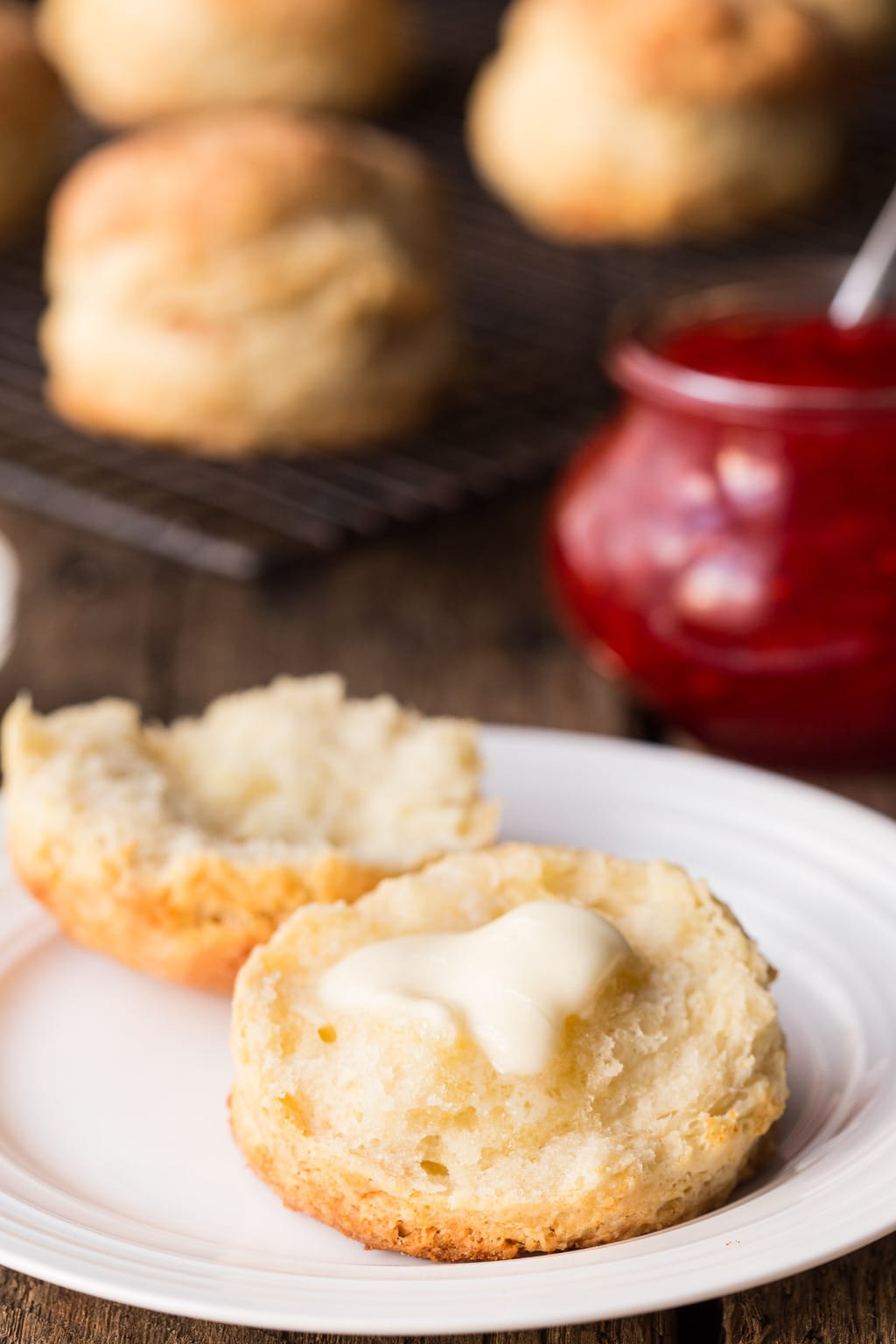
When the warm butter hits the cold liquid, small, buttery globules form as you can see in the picture below.
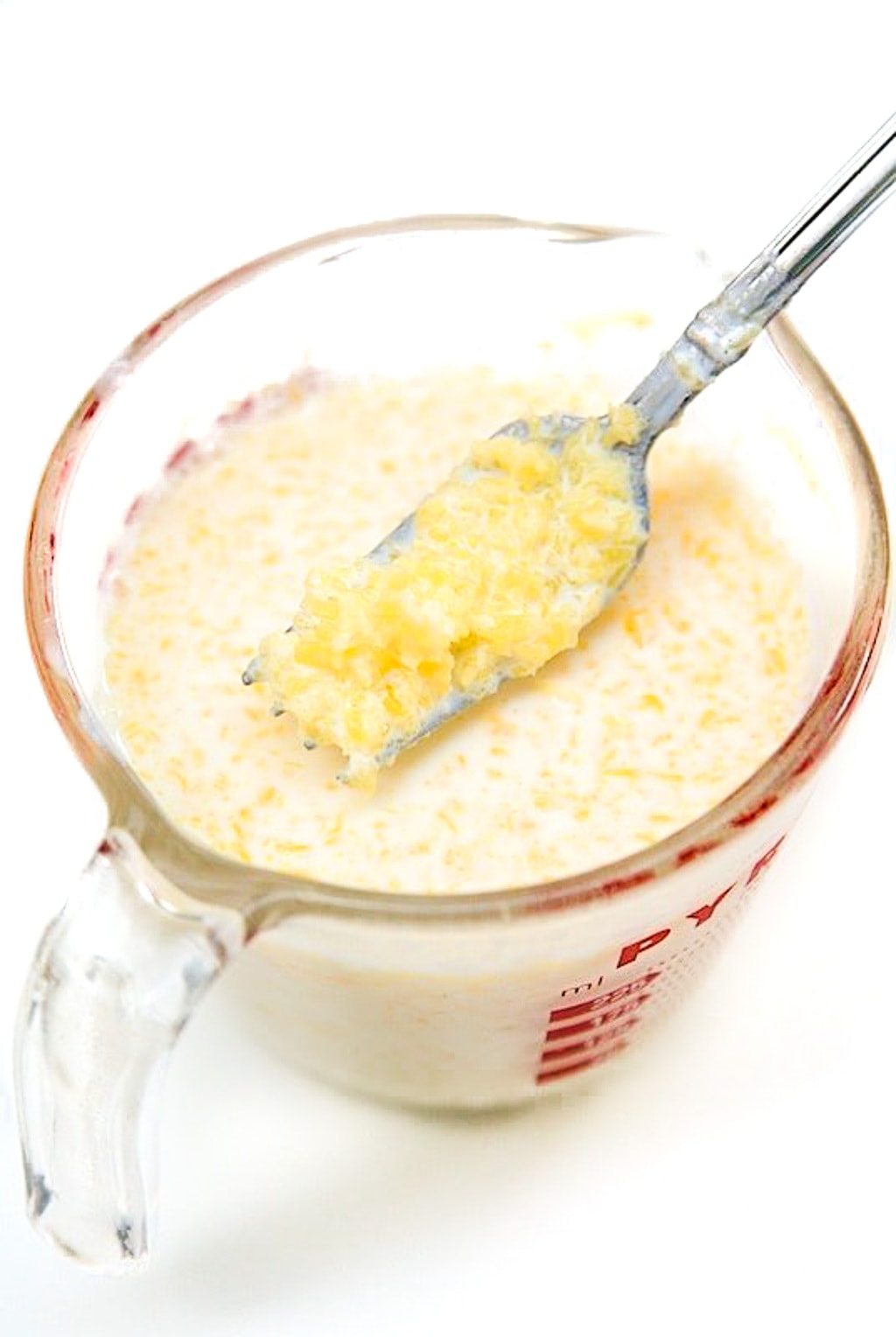
Do you see where this is going? When this buttermilk mixture is added to the dry flour mixture and it's all stirred together, you'll notice tiny pieces of pale yellow butter dotting the simple dough. Yep, it will look just as if you spent the time to cut them in!
Would this technique work for traditional, rolled biscuits?
The Cook's Illustrated recipe is for simple drop biscuits, meaning you just drop spoonfuls onto a sheet pan, then bake. Would this technique work for a more classic, cut-out style biscuit, I wondered? You never know until you try, so I decided to give it a whirl!
I turned out the dough onto a floured work surface, kneaded it a few times, then patted it into a small, square. Dipping a round biscuit cutter in flour, I cut four circles, then rerolled the scraps and cut two more for a total of six. (Since then, I've also used a smaller cutter, yielding 8 biscuits.)
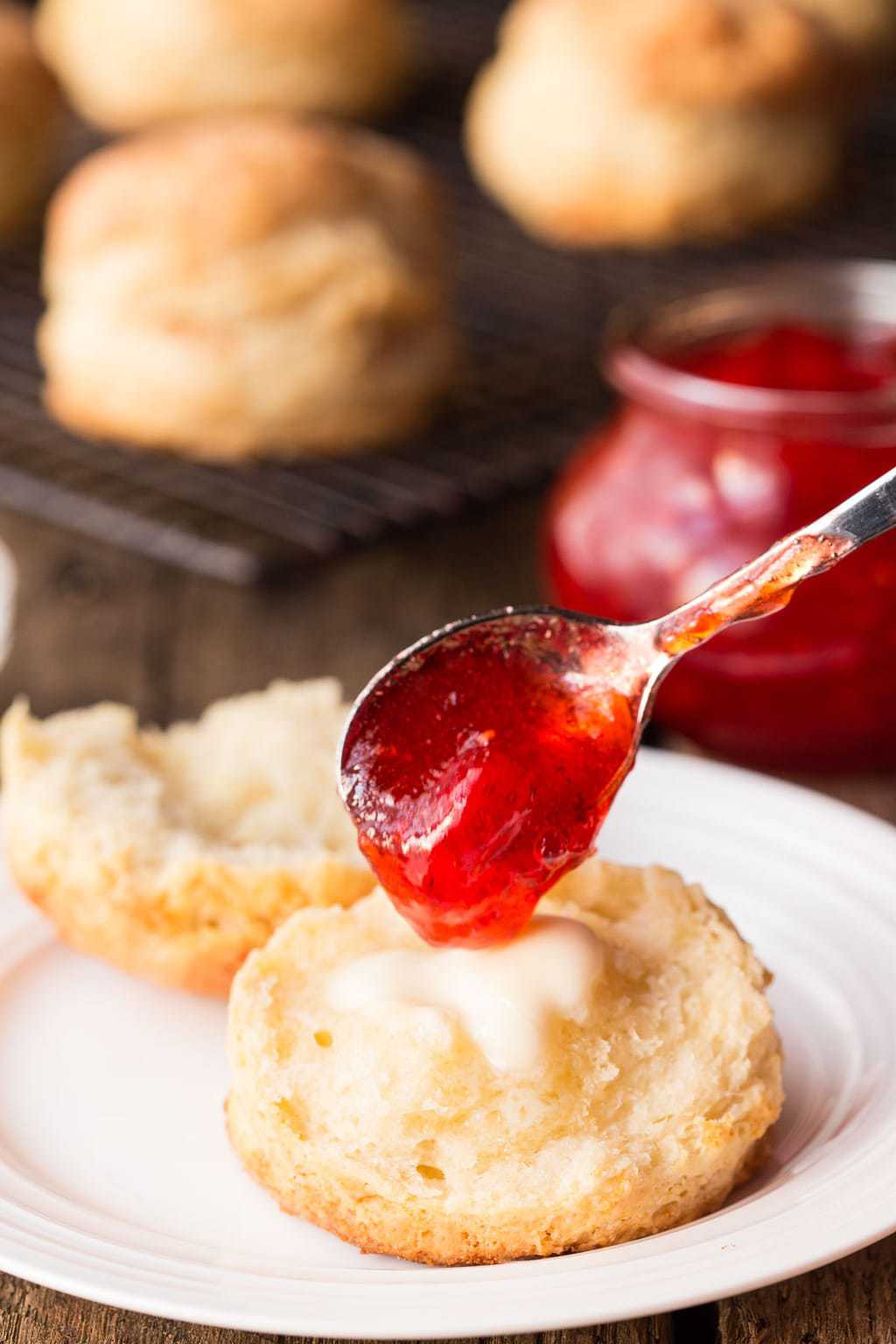
It was easy enough; actually ridiculously easy! The biscuits rolled out of the oven tall and golden brown with a heavenly aroma. But you're probably wondering how this version tastes and how they stack up to traditional buttermilk biscuits, right?
The results?
When Scott and I took the first bite, we looked at each other incredulously. The biscuits were light, tender, buttery, flaky and crazy-delicious. "Wow, these are amazing!" Scott said. I agreed.
In fact, we ate far too many that day, smothered with melted butter and strawberry jam. You'd probably frown on us if I told you these biscuits also ended up being dinner that night, so I won't share that bit of information. I guess I'll just say, it wouldn't have been a good day for counting calories!
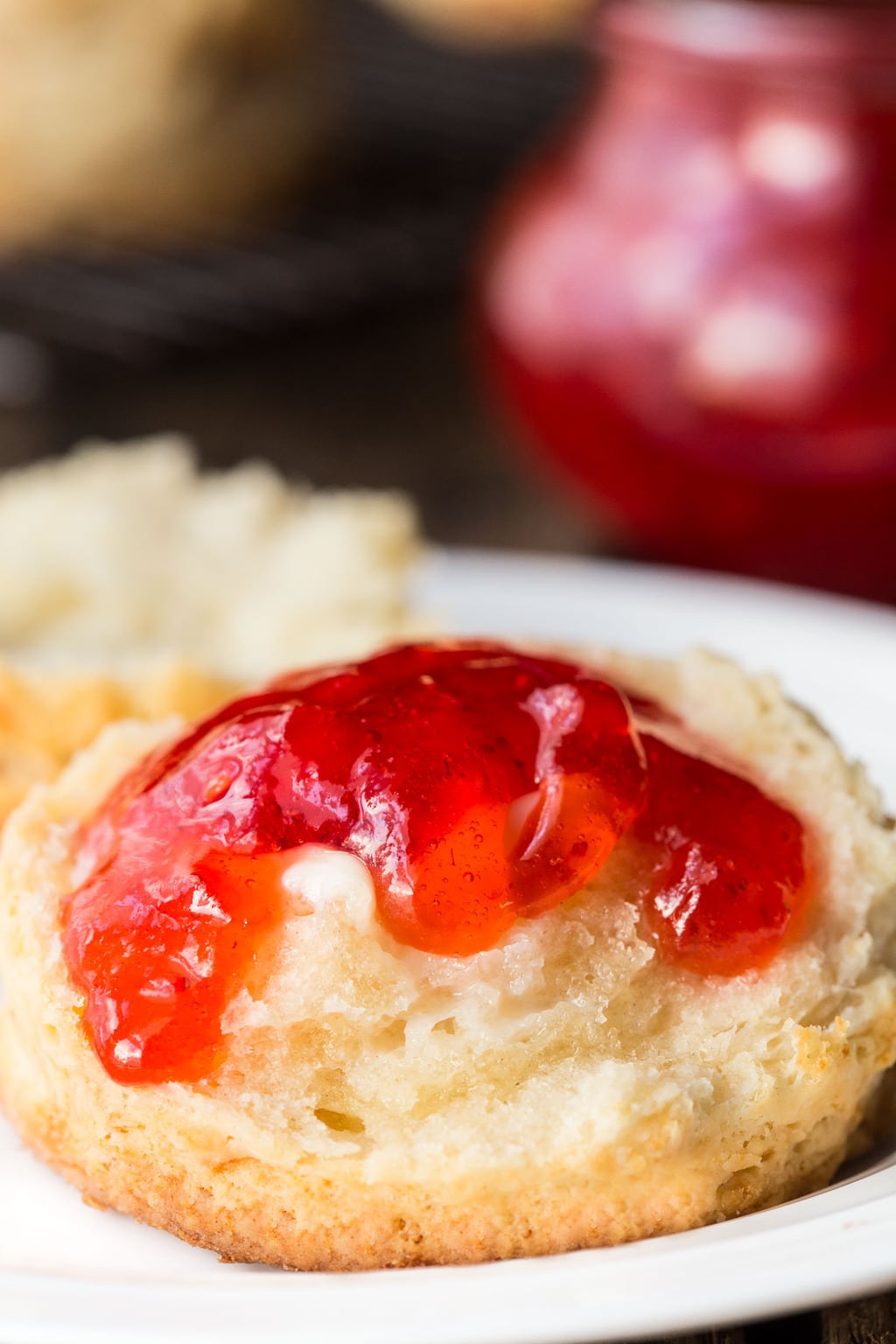
I've had quite a few happy taste-testers since then, and everyone is shocked when they hear how easy these wonderful buttermilk biscuits are to make. In fact check out the video below, to see for yourself!
Try it! You'll be shocked (and delighted) too... you might even have the inclination to exclaim "Brilliant, simply brilliant!"
Bon Appétit!
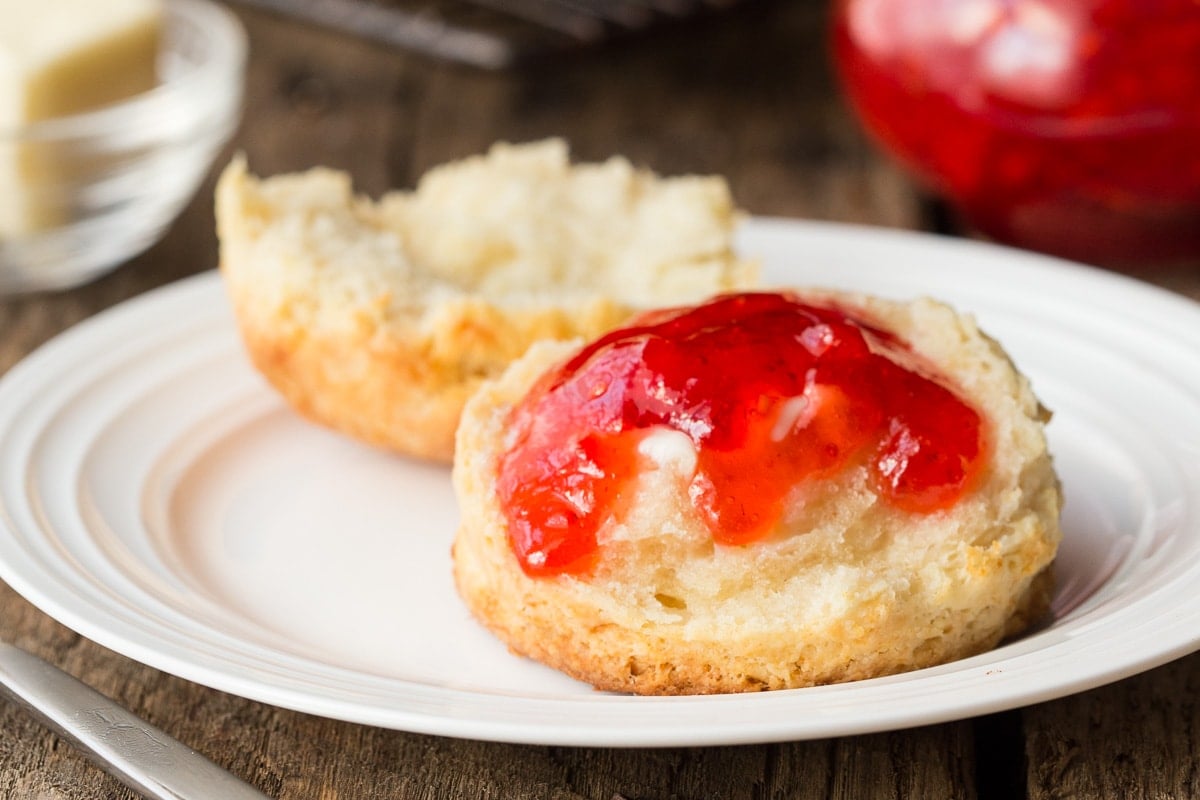
Café Tips for making Buttermilk Biscuits
- If you don't have buttermilk, make your own. Place 1 tablespoon of fresh lemon juice or vinegar in a measuring cup. Fill to 1 cup level with milk and stir well. Allow to sit for 5-10 minutes or until slightly thickened. The mixture may curdle a bit, that's okay! Use in recipes in lieu of buttermilk.
- Don't skip chilling the buttermilk (step 2). It will definitely make a difference. If the buttermilk isn't really cold, the little butter globules won't form.
- I made these biscuits when I was in London visiting my daughter. I learned that all-purpose flour (Plain flour) is a bit different there and it seemed like I needed more, probably closer to 2 ¼ cups.
- These biscuits freeze well, both unbaked and baked. To freeze them unbaked or baked, place biscuits on a sheet pan or a plate spaced at least a half-inch from each other. Freeze till frozen, then transfer biscuits to a ziplock bag or air-tight storage container. If you've frozen them unbaked, bake them as directed in the recipe right from the freezer. Give them a couple extra minutes in the oven to compensate for the fact that they were frozen.
- If you freeze these buttermilk biscuits after baking, allow them to thaw when you're ready to use them and then warm in the oven for 5-8 minutes at 300˚F.
- If I'm feeling a bit pinched for time or just lazy, I'll pat the dough into a 6-inch circle and use a bench scraper to cut the dough into wedges. I either put these wedges on a sheet pan lined with parchment paper or in a 9-inch cake pan lined with parchment.
- Another shortcut is to simply scoop up the dough, right from the bowl onto a sheet pan and bake as directed.
- We love to serve these biscuits with our Easy Strawberry Freezer Jam or this Overnight Raspberry Freezer Jam.
Love these biscuits? Then you'll also go crazy over these Ridiculously Easy Cheddar Chive Biscuits, made with the same easy technique!
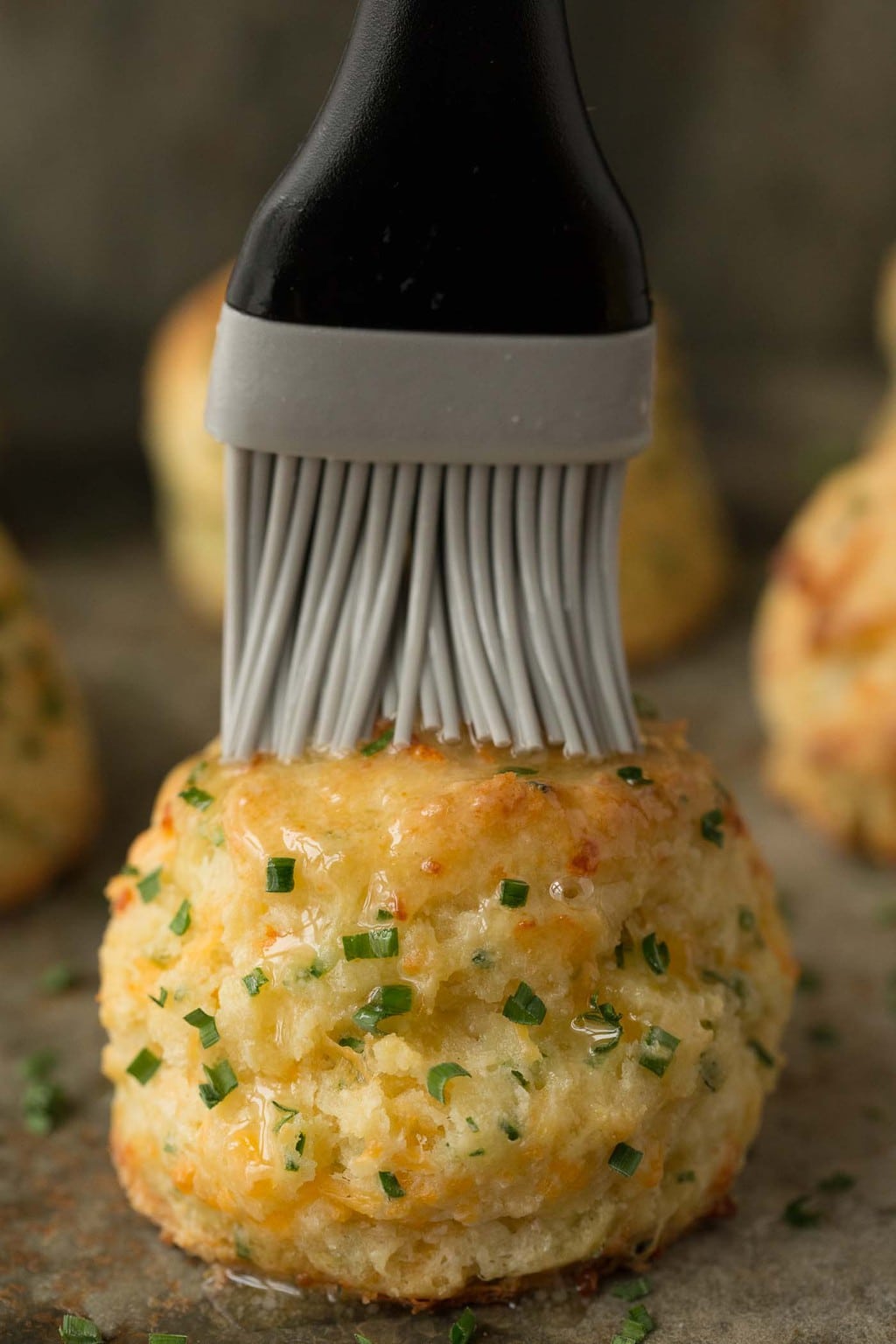
Thought for the day:
Show me your ways, Lord,
teach me your paths.
Guide me in your truth and teach me,
for you are God my Savior,
and my hope is in you all day long.
Psalm 25:4&5
What we're listening to for inspiration:
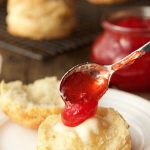
- 1 cup buttermilk
- 9 tablespoons butter divided
- 2 cups all purpose flour more for counter
- 1 tablespoon sugar
- ½ teaspoon baking soda
- 2 teaspoons baking powder
- ¾ teaspoon table salt
-
Adjust oven rack to middle position and heat oven to 450°F. Line a sheet pan with parchment paper or spray a sheet pan with cooking spray.
-
Measure 1 cup of buttermilk and place in the freezer for 10 minutes while prepping other ingredients.
-
Place butter in a microwave-safe bowl, cover and heat on high for 30 seconds. If not completely melted, return to microwave for 10-second intervals till melted. Set aside while prepping other ingredients.
-
Whisk flour, baking powder, baking soda, sugar,and salt in large bowl.
-
After buttermilk has been chilled in the freezer for 10 minutes, combine it with 8 tablespoons of the melted butter. (Reserve the last tablespoon for brushing on the baked biscuits.) Stir with a fork until butter forms small clumps or globules. (See picture in the post.)
-
Add buttermilk mixture to dry ingredients and stir with a rubber spatula just until all flour is incorporated and batter pulls away from sides of the bowl. The dough should be stiff and not super wet. If the dough is wet, add more flour 1 tablespoon at a time, stirring to combine, until fairly stiff.
-
Generously flour a work surface. Dump biscuit dough from bowl onto prepared work surface and turn to coat all surfaces with flour. Knead on counter 5-6 times (about 30 seconds). Flip over on the work surface to coat with flour then pat into a 6-inch square. It should be a 1½-2-inches in height.
-
Cut four biscuits with a 2 ½-inch biscuit cutter. Place biscuits on the prepared sheet pan. Knead scraps a few times till they hold together, then pat into a small rectangle and cut two more biscuits. Transfer last two biscuits to the sheet pan, spacing about 1 ½ inches apart. (See Café Tips in the post for an even easier cutting technique).
-
Place in oven and bake until tops are golden brown and crisp, 8 to 18 minutes. (start checking them after 8 minutes as ovens vary. You want them to be a nice golden brown, but not too brown - check the pictures above for correct color.)
-
Re-melt remaining tablespoon of butter in the microwave, if necessary and brush tops of hot biscuits with melted butter. Serve and enjoy!


Tina says
Do you have to add the sugar? Not a fan of sweet biscuits.
Chris Scheuer says
Hi Tina, these biscuits are not sweet. The sugar just helps balance the flavor but you can skip it if you prefer.
Kimber says
I made them! So they taste *so good*. But there ugly. Who cares! I did want to ask, can I refrigerate the dough before cutting or dropping next time? I had to use SO much flour on my counter and they would not unstick. I was worried I’d added too much flour at the end. Still turned out good, just don’t want to deal with the stress of sticking to the counter again.
Chris Scheuer says
Hi Kimber, you can refrigerate the dough but I wouldn't do it for more than 10-15 minutes or it won't be easy to work with.
CRYSTAL says
I can't believe I waited this long to try making biscuits. I make them now and it's so easy. I make some for the freezer and when my college son comes with friends I make delicious breakfast sandwiches and they rave about them!
Lindsay @ The Café Sucre Farine says
That's great, Crystal! Thank you for the review!
Ellen says
I Love this recipe! So easy and delicous. Have you ever tried it with cake flour? It is all I have right now. Thanks, Ellen
Chris Scheuer says
Hi Ellen, I haven't made these with cake flour but it should be fine!
Palma says
Great recipe! Thank you so much! I was being lazy so I didn't want to roll the dough out plus I like when the edges are soft, so I put them in muffin tins. They turned out great! The top and bottom were crispy. Very delicious! Melting the butter and pouring it into cold buttermilk is genious! After I added the butter, I threw it back in the refriderator for 15 plus minutes while i was doing some other things. I will continue to use this recipe! Thanks again!
Lindsay @ The Café Sucre Farine says
Great! Thanks for the review, Palma!
Rachel Wood says
I agree! Very easy and DELICIOUS! My husband described them as “restaurant quality”! This will also be my new go-to biscuit recipe 🙂
Lindsay @ The Café Sucre Farine says
Awesome! Thanks for the review, Rachel!
Holly Beth says
I found this recipe and did the same thing, went straight to the kitchen to give it a try.
Ridiculously easy is correct!! I whipped these up and once they cooled, we went at 'em! OMG!! They were PERFECTION!! Light, fluffy and absolutely delicious! This will definitely be my go-to biscuits recipe from now on!!
Thanks for sharing!!
Lindsay @ The Café Sucre Farine says
Awesome! Thanks for the review, Holly!
Kelly Dolin says
Can this recipe be doubled? I need a dozen biscuits, and would prefer to make them all at once.
Chris Scheuer says
Hi Kelly, you could double the recipe but make sure to use a very large bowl.
Jill Luettgens says
I have been making Baking Powder Biscuits for years but these are truly a southern biscuit with all the feels! I make soup all the time and I guess this will be my new recipe. I am happy to see you can make them and freeze them- saves times when you have friends over.
Lindsay @ The Café Sucre Farine says
Thank you for the review, Jill!